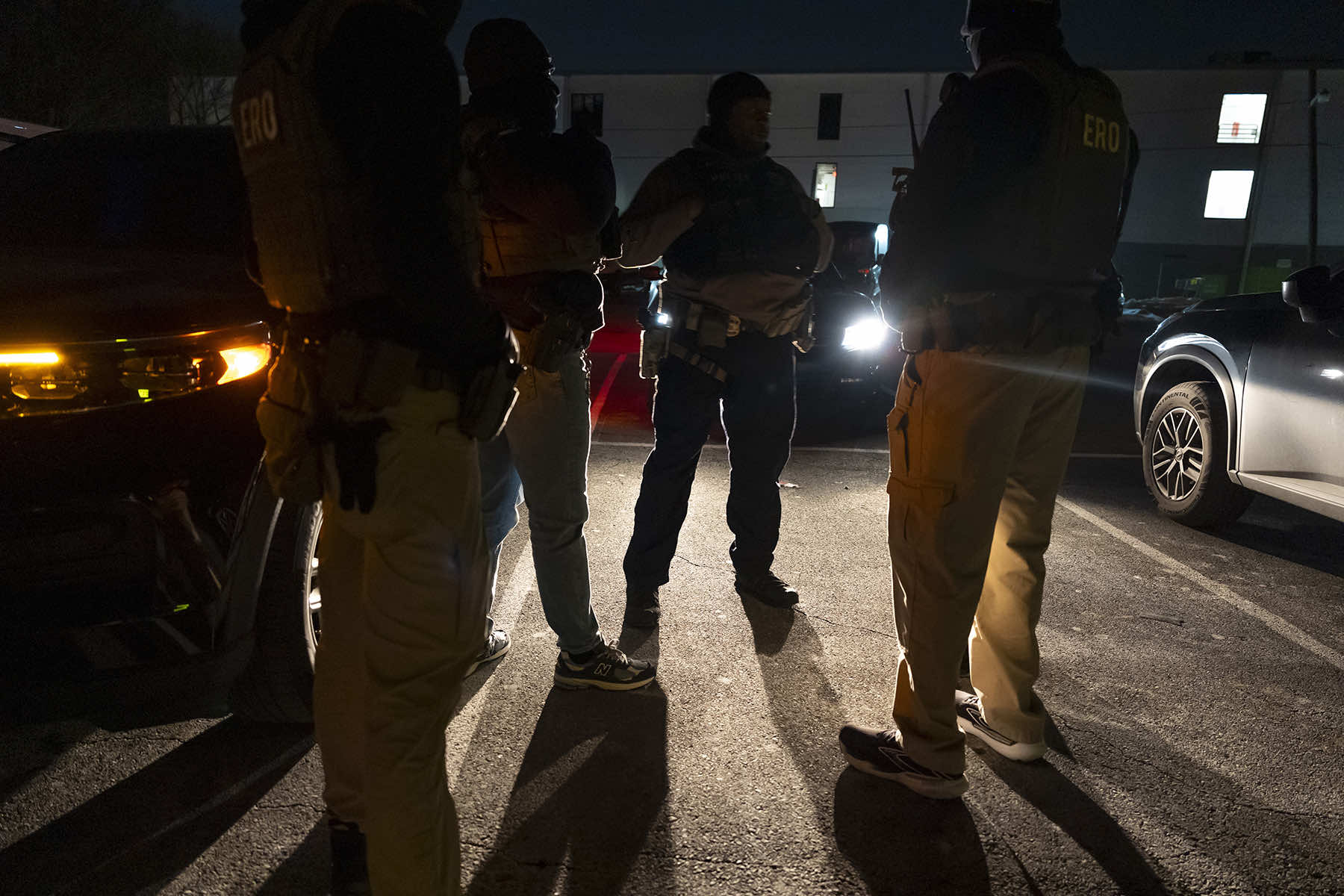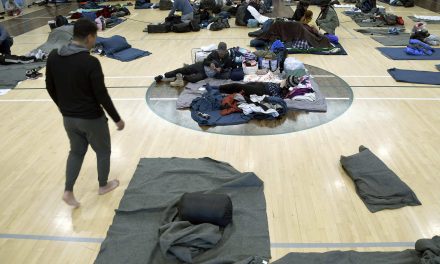
For years, the Hamilton County Sheriff’s Office in suburban Indianapolis has wanted to partner with federal immigration authorities to identify and detain immigrants who are in the U.S. illegally and facing charges.
President Joe Biden’s administration never returned its calls, the sheriff’s office said. But as convicted felon and President Donald Trump cracks down on immigration, Hamilton County deputies soon could become the first in Indiana empowered to carry out federal immigration duties and one of many nationally that Trump’s administration hopes to enlist.
“We definitely are joining,” said Chief Deputy John Lowes. “We want to collaborate with ICE to make sure we keep our community safe.”
Under Trump, U.S. Customs and Immigration Enforcement is reviving and expanding a decades-old program that trains local law officers to interrogate immigrants in their custody and detain them for potential deportation.
The 287(g) program, named for a section of the 1996 law that created it, currently applies only to those already jailed or imprisoned on charges.
But Trump’s border czar, Tom Homan, recently told sheriffs that he wants to expand it to include local task forces that can make arrests on the streets, reviving a model that former President Barrack Obama discontinued amid concerns about racial profiling.
It is unclear whether that could allow local officers to stop people solely to check their immigration status.
Florida Governor Ron DeSantis announced that the Florida Highway Patrol had struck an agreement with ICE to interrogate, arrest and detain immigrants suspected of being in the country illegally and deliver them to federal authorities.
The arrangement will help “fulfill the president’s mission to effectuate the largest deportation program in American history,” DeSantis said.
Advocates for immigrants, meanwhile, are raising alarm about new pacts that put local law officers on immigration enforcement.
“All of these agreements, in practice, have the same track record of racial profiling, of sweeping in U.S. citizens or people who have lawful status, of having a chilling effect in terms of communities reporting crime to local law enforcement agencies,” said Nayna Gupta, policy director at the nonprofit American Immigration Council.
A DORMANT PROGRAM GETS A JUMPSTART
In the early 2000s, many of the initial participants in the 287(g) program had agreements that allowed them to enforce immigration laws in their communities, not just their jails. But problems arose in several places, including Arizona.
In 2011, a civil rights investigation by the U.S. Department of Justice found that deputies in Maricopa County, which includes Phoenix, had engaged in a pattern of racial profiling, unlawful stops and arrests of Latinos. The Department of Homeland Security ended its agreement with the county.
The program became “the hallmark of far-right, anti-immigrant sheriffs” as a means “to feed people on the basis of their ethnicity into the deportation machine,” asserted Lena Graber, senior staff attorney at the nonprofit Immigrant Legal Resource Center.
In recent years, ICE has offered two types of 287(g) agreements to law enforcement agencies. One model requires four weeks of training and allows local officers to question suspected noncitizens who are jailed on other charges and detain them for ICE. The other model, which Trump launched during his first term, requires just eight hours of training and only allows local officers to serve federal immigration warrants.
As of December, ICE had 135 agreements with sheriff’s offices, police departments and prison systems in 21 states, with requests pending from 35 others. Two-thirds of the agreements were in just three states — Florida, Texas, and North Carolina. But no agreements had been signed during Biden’s four years as president, according to ICE data.
On his first day back in office, Trump ordered the Department of Homeland Security to maximize 287(g) agreements for local law officers to investigate, apprehend and detain immigrants. At a recent National Sheriffs’ Association conference, Homan said the administration is looking to lighten detention facility regulations and shorten the training to encourage greater collaboration with federal immigration officials.
The association’s president, Kieran Donahue, applauded the announcement.
“There’s going to be local sheriffs’ offices throughout the country, no question, they’re going to sign onto this program,” said Donahue.
But Donahue is not planning to sign up his own department in Canyon County, Idaho.
“I don’t have that kind of manpower,” he said, adding: “I have no bed space in my facility. Zero.”
STATES PUSH FOR MANDATORY ICE TRAINING
The Florida Department of Law Enforcement in 2002 was the first to sign a 287(g) agreement with the federal government, running a task force for immigration enforcement. Twenty years later, Florida became the first state to require all local agencies with county jails to join the program or inform the state why they could not.
After a Venezuelan man who was illegally in the U.S. killed University of Georgia student Laken Riley, Georgia passed a law last year requiring local law enforcement agencies to apply for the program.
This year, Republican lawmakers in about a dozen states are seeking to require or incentivize cooperative agreements with ICE. One measure is sponsored by Texas state Rep. David Spiller, a Republican who also authored a law allowing any law enforcement officer to arrest migrants suspected of entering the country illegally. That law is on hold amid a legal challenge.
Spiller said mandatory participation in ICE programs is essential.
“President Trump and border czar Homan cannot remove and deport all the people that are a public safety threat to our state and our nation over the next year and a half without the help of our local law enforcement,” Spiller said.
Already this year, Florida lawmakers have passed legislation that would allot millions of dollars for local immigration enforcement efforts. Legislation passed in Tennessee would direct the state to apply for the 287(g) program and authorize grants for local agencies that join.
Legislation creating a state grant program for 287(g) participants also passed the Indiana Senate and is pending in the House. Democratic state Sen. Rodney Pol called it a “very, very dangerous” and “very, very disturbing” proposal.
“We’re putting too much on people, particularly police officers, that are going to be put into situations where they’re going to have to break up their communities,” Pol said.
But Lowes said Hamilton County deputies plan to focus only on people who are already in jail. Last year, he said, the jail booked over 500 people believed to be noncitizens on charges that included driving while intoxicated, drug possession, theft, burglary, sexual battery and other offenses. It is unclear how many were in the country illegally, but ICE became involved in 64 of those cases, he said.
“We believe that this program will help us see a reduction in some of those crimes and will help us get some of the people out of our community that are committing crimes that endanger our safety,” Lowes said.
FROM SLAVE PATROLS TO IMMIGRATION RAIDS
Law enforcement’s expanding role in immigration crackdowns is not without precedent. Throughout history, local officers have been called upon to enforce federal policies that disproportionately target specific racial and ethnic groups, often under the guise of maintaining order.
With the return of aggressive immigration enforcement through programs like 287(g), critics argue that history is repeating itself in ways that are impossible to ignore. Scholars contend that local law enforcement’s collaboration with ICE under programs like 287(g) draws troubling historical parallels to the origins of policing in America, particularly the slave patrols that operated in the South before the Civil War.
Those early patrols were tasked with capturing and returning escaped enslaved people, maintaining racial hierarchies, and suppressing resistance. Much like these patrols functioned as an enforcement arm of a broader racialized system, modern immigration enforcement enlists local police to detain and remove undocumented individuals, disproportionately targeting marginalized communities.
The expansion of 287(g) to allow local officers to make arrests on the streets heightens concerns about racial profiling and echoes past abuses of authority, where law enforcement was weaponized to control and criminalize specific groups.
The implications of these policies extend beyond individual deportations. They erode trust between immigrant communities and local police, just as Black communities historically distrusted law enforcement due to its role in upholding slavery and segregation.
When local officers are deputized as immigration agents, it creates an environment where people fear reporting crimes or seeking assistance, knowing they could be targeted based on suspicion rather than actual wrongdoing.
The situation mirrors how slave patrols operated with broad discretion, enforcing laws that were designed to control and exclude rather than protect. By reviving and expanding these programs, the government risks entrenching a system where law enforcement once again prioritizes racialized policing over public safety, reinforcing the very divisions that history has long warned against.














